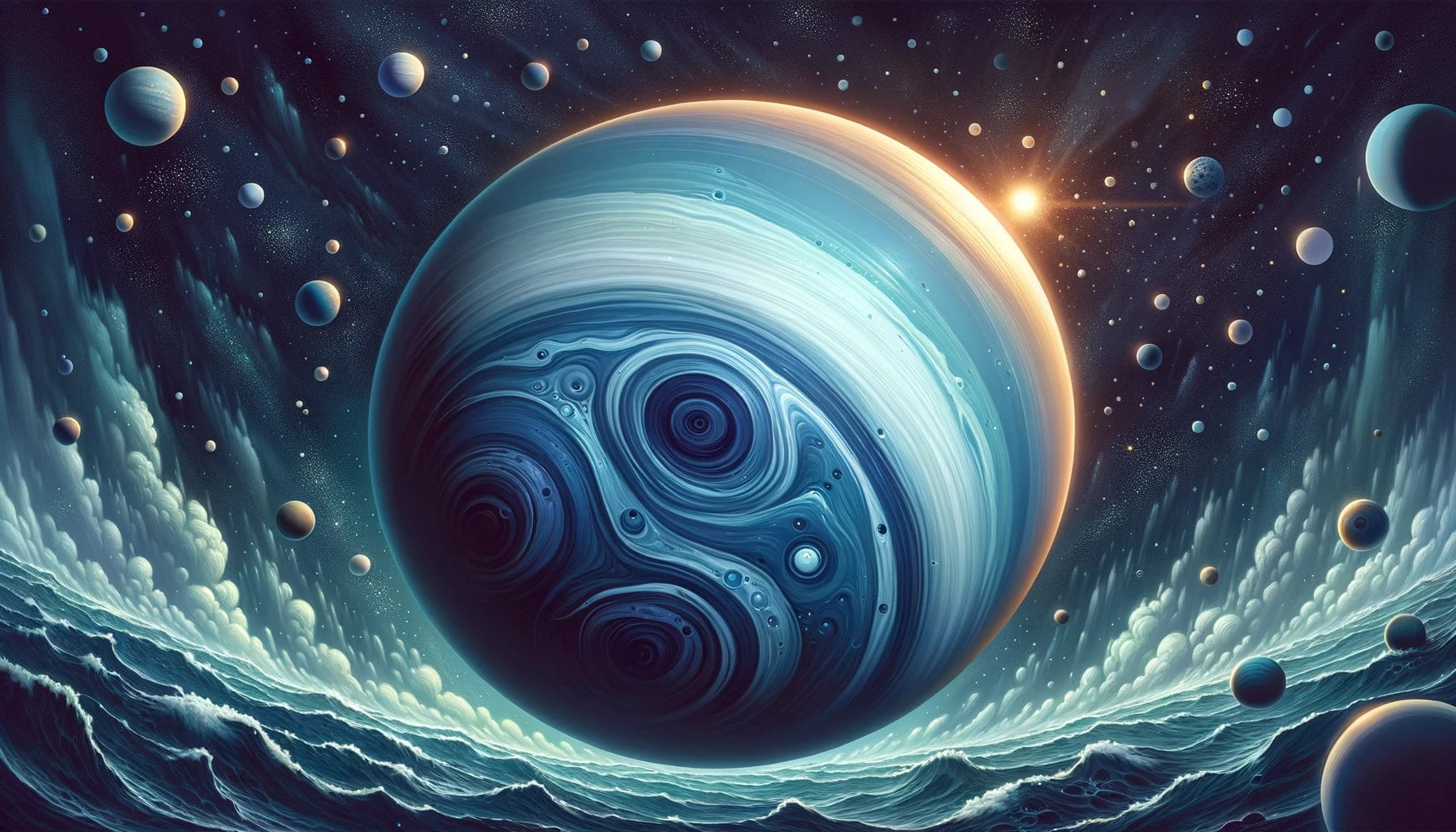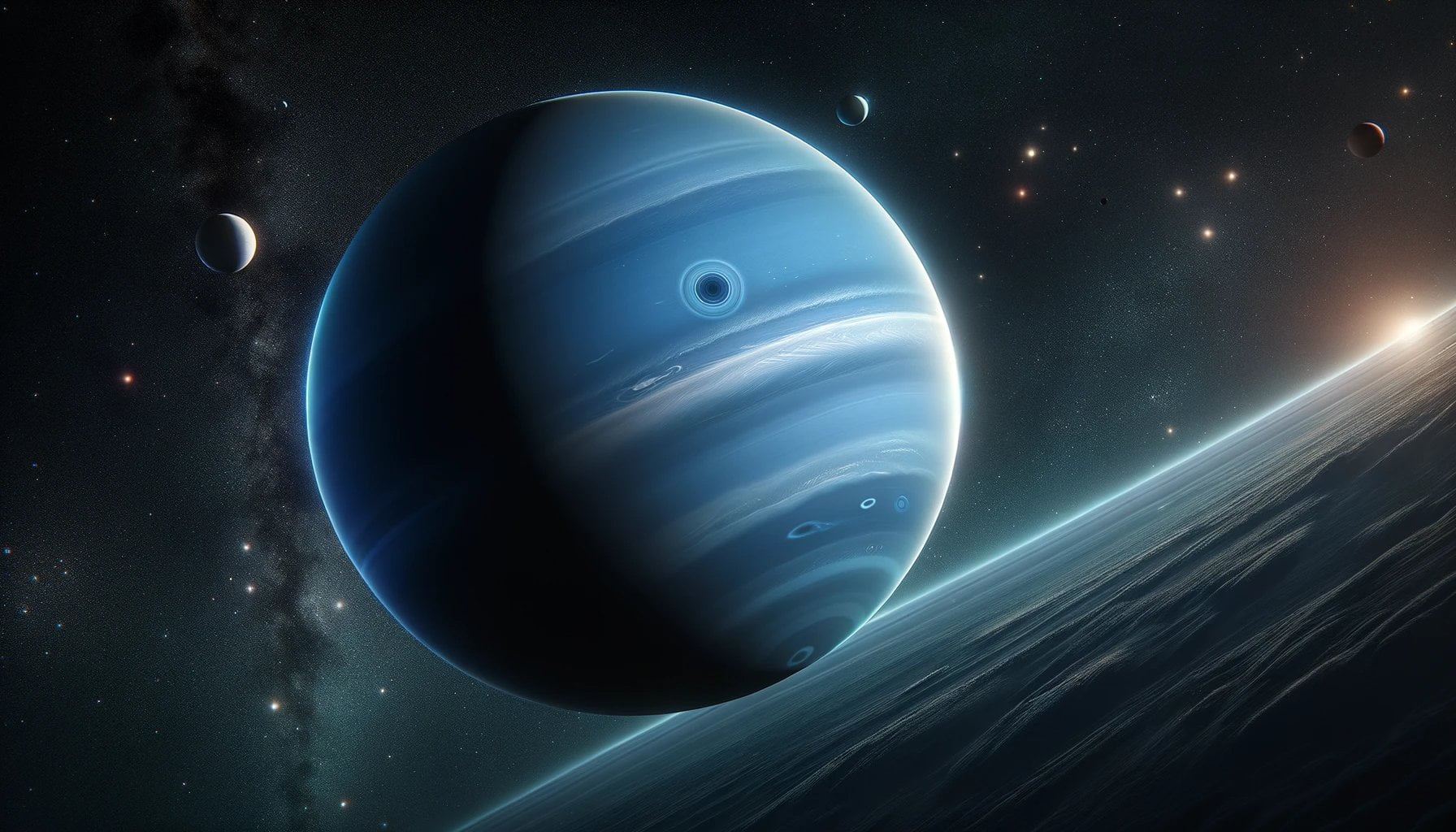Unveiling Neptune’s Enigmatic Brilliance: Exploring the Wonders of the Solar System’s Mystical Blue Giant is an intriguing journey into the enigmatic wonders of the planet Neptune. As we delve into the depths of this mesmerizing celestial body, we unravel the secrets that make Neptune so special in our solar system. With its striking blue hue and mysterious atmospheric dynamics, Neptune offers a captivating glimpse into the mesmerizing mysteries of our universe. Join us as we embark on an exploration of Neptune’s brilliance, uncovering the celestial marvels that make this distant planet truly extraordinary.

Key Takeaways:
- Neptune is the most distant, smallest, and densest of all the gas giants in our solar system.
- Urbain Le Verrier and John Couch Adams are credited with discovering Neptune through mathematical predictions.
- Neptune is the coldest planet in our solar system, with temperatures as low as -366 degrees Fahrenheit.
- Its atmosphere consists of a thick fog of water, ammonia, and methane, and it has an Earth-sized solid center.
- Despite being smaller in size than other gas giants, Neptune is actually more massive than Uranus.
- Neptune is the farthest planet from both the Earth and the Sun since Pluto lost its planet status in 2006.
- It is approximately 4.3 billion kilometers away from Earth at its closest.
- Neptune has 14 moons, with Triton being the largest and most notable.
- The unique characteristics of Neptune make it a captivating subject for scientific study and exploration.
Why is Neptune so special?
Neptune, the mystical blue giant of our solar system, is a planet that holds a multitude of extraordinary characteristics that set it apart from its celestial siblings. From its captivating discovery to its bone-chilling temperatures and enigmatic atmosphere, Neptune continues to intrigue astronomers and space enthusiasts alike. So, why is Neptune so special? Let’s dive deep into the wonders of this unique gas giant.
Discovery and Naming: A Tale of Mathematical Predictions
Neptune’s story begins with a fascinating discovery intertwined with mathematical predictions and international disputes. Named after the Roman god of the sea, Neptune holds the distinction of being the last planet in our solar system to be found. Credit for its discovery is attributed to a collaboration between Urbain Le Verrier, a French mathematician, and John Couch Adams, an English mathematician. Their calculated predictions led to the sighting of this captivating planet, forever etching their names in astronomical history.
Extreme Cold and Atmospheric Composition: Where Mystery Meets Chemistry
When it comes to bone-chilling temperatures, Neptune truly takes the cake. With frigid temperatures plummeting as low as -366 degrees Fahrenheit, it earns the title of the coldest planet in our solar system. But what lies within its atmosphere? Neptune’s dense fog is composed of water, ammonia, and methane, giving it a true ice giant identity rather than conforming to the classic gas giant archetype. It’s a planet shrouded in mystery and filled with otherworldly chemistry.
Size and Density: Defying Expectations
Although Neptune may appear smaller compared to its gas giant counterparts like Jupiter, Saturn, and Uranus, don’t be deceived by its size. In fact, it is more massive than Uranus by approximately 18%. Its compact nature and higher density arise from its greater mass, leading to a gravitational compression of its atmosphere and defying our expectations of planetary proportions. Neptune may be smaller, but it packs a mighty punch.
Distance from Earth: A Distant Beauty
With the unfortunate demotion of Pluto from planet status in 2006, Neptune secures the title of being the farthest planet from both the Earth and the Sun. Its ever-shifting distance from us adds an element of mystery to this celestial beauty. At its closest approach, Neptune rests approximately 4.3 billion kilometers away, showcasing the vast expanse of our solar system and reminding us of the untamed wonders that lie beyond.
Moons: A Retinue of Enigmatic Companions
Neptune’s allure is further enhanced by the presence of its retinue of 14 moons. Among them, Triton reigns supreme as the largest and most striking. These moons add to the mystique and fascination surrounding this distant gas giant, providing potential targets for future exploration and expanding our understanding of the outer reaches of our solar system.
As we delve deeper into the mysteries of Neptune, the more we realize its unique and awe-inspiring nature. Its captivating discovery, bone-chilling temperatures, dense atmosphere, distant location, and captivating moons all contribute to its enigmatic brilliance. Neptune invites us to keep exploring, keep questioning, and continue unraveling the wonders of our universe.
Sources:
- FactCity: Neptune: Fun Facts
- Universe Today: 10 Interesting Facts About Neptune
Did you know that Neptune, the eighth planet in our solar system, has some fascinating facts? Click here to uncover 5 intriguing facts about Neptune! 5 facts about neptune
Curious to learn more about Neptune’s fun facts? Dive into this article to discover interesting tidbits about this mysterious planet. What are Neptune’s fun facts?
Ever wondered how hot Neptune can get? Brace yourself as you explore the scorching temperatures on the surface of this distant planet. How hot is Neptune?
Who is the god of Neptune? Unveil the mythological origins and extraordinary significance of this deity. Who is Neptune God?
Neptune’s Great Dark Spot and Other Atmospheric Features
Neptune’s Great Dark Spot: A Window into the Mysteries of the Blue Giant
Neptune, the enigmatic blue giant of our solar system, holds within its atmosphere a captivating feature known as the Great Dark Spot. This prominent atmospheric phenomenon first caught the attention of scientists when the Voyager 2 spacecraft flew past Neptune in 1989. Similar in appearance to Jupiter’s Great Red Spot, Neptune’s Great Dark Spot is elliptically shaped and possesses a mysterious allure that continues to intrigue astronomers.
Unlike its Jupiter counterpart, which remains confined to a specific latitude, the Great Dark Spot of Neptune has the remarkable ability to shift its position north and south over time. This unpredictable movement adds to its intrigue, making it a dynamic and ever-changing element of the Neptunian atmosphere. Spanning a size comparable to Earth itself, this dark and tempestuous feature is not to be underestimated.
A Wondrous Display of Power and Mystery
The Great Dark Spot is a testament to the immense power of the winds on Neptune. In fact, it holds the record for one of the strongest winds ever recorded in our solar system. So what causes this mesmerizing dark spot to form and persist? It is believed to be the result of powerful storms churning within the atmosphere of Neptune, much like the storms that drive Jupiter’s Great Red Spot.
Observations made by the Hubble Space Telescope have shed light on the dynamic nature of Neptune’s Great Dark Spot. Its ever-changing appearance, coupled with the presence of material that makes the aerosol layer at 5 bar darker, indicates a complex interplay of atmospheric processes at work. Even ground-based telescopes have captured stunning images of this feature, showcasing the richness and complexity of Neptune’s atmospheric dynamics.
The Allure of Neptune’s Atmospheric Features
Neptune’s Great Dark Spot is not alone in its atmospheric mystique. This distant planet is known for its array of dark spots, akin to Jupiter’s Great Red Spot. These atmospheric features add to the allure of Neptune, drawing us deeper into the mysteries of this icy giant.
From their elliptical shapes to their shifting positions and the storms they harbor, these atmospheric phenomena offer insights into the complex dynamics of Neptune’s atmosphere. While much remains to be uncovered, the study of these features brings us closer to understanding the uniqueness of this distant world.
Key Takeaways:
- Neptune’s Great Dark Spot, similar to Jupiter’s Great Red Spot, is a prominent feature within the planet’s atmosphere.
- Unlike Jupiter’s spot, Neptune’s Great Dark Spot can shift its position north and south over time.
- The dark spot is about the same size as Earth and exhibits one of the strongest winds ever recorded in the solar system.
- Powerful storms in Neptune’s atmosphere are believed to be the cause of the Great Dark Spot’s formation and persistence.
- Observations from the Hubble Space Telescope and ground-based telescopes unveil the dynamic nature of Neptune’s atmospheric features.
Sources:
- NASA RPS: Radioisotope Power Systems – Neptune’s Great Dark Spot (NASA)
- Cool Cosmos – What is the Great Dark Spot? (Caltech)
Neptune’s Mysterious Magnetic Field
Did you know that Neptune, the mystical blue giant of our solar system, possesses a magnetic field that continues to baffle scientists? This enigmatic phenomenon, known as Neptune’s Mysterious Magnetic Field, has captured the attention of astronomers and astrophysicists alike. Let’s dive into the wonders of this captivating celestial mystery.
Neptune’s magnetic field was first detected in 1989 by the Voyager 2 spacecraft, and it immediately stood out as something peculiar. Similar to Earth’s magnetic field, Neptune’s magnetic field can be represented approximately by that of a dipole. However, a striking difference lies in the polarity – Neptune’s magnetic field is essentially opposite to that of Earth’s present field[^1^].
But that’s not where the intrigue ends. Compared to Earth, Neptune’s magnetic field is approximately 27 times more powerful[^2^][^3^]. Moreover, it is tilted at a staggering 47 degrees from the planet’s rotation axis and is offset at least 0.55 radii from the physical center[^4^]. This misalignment between the magnetic field and the planet’s rotation causes Neptune’s magnetosphere to undergo wild variations during each rotation[^2^].
To put it simply, Neptune’s Mysterious Magnetic Field is a phenomenon that defies our conventional understanding of magnetic fields. This captivating celestial puzzle continues to fuel scientific exploration and curiosity.
Key Takeaways:
- Neptune’s magnetic field, detected by Voyager 2 in 1989, exhibits characteristics that perplex scientists.
- Similar to Earth’s magnetic field, Neptune’s field can be represented as a dipole, but its polarity is essentially opposite.
- Neptune’s magnetic field is about 27 times more powerful than Earth’s.
- The field is tilted 47 degrees from Neptune’s rotation axis and offset at least 0.55 radii from the physical center, causing wild variations in the magnetosphere during each rotation.
Sources:
– [^1^]: Neptune – Magnetic Field, Magnetosphere, Rings …
– [^2^]: Neptune’s Strange Magnetic Field Stretches Arms in New Model (Video) | Space
Neptune’s Relationship with Pluto and the Kuiper Belt
The vast expanse of our solar system never ceases to amaze. From the scorching sun to the frozen outposts at its fringes, each celestial body holds its own allure. Amidst this cosmic dance, Neptune emerges as a captivating enigma, surrounded by the mysteries of its relationship with Pluto and the Kuiper Belt. Let’s embark on a journey to unravel the secrets of this distant blue giant and its cosmic companions.
Exploring the Kuiper Belt: A Cosmic Doughnut
Beyond the familiar orbits of the planets lies a fascinating region called the Kuiper Belt[^1^]. Named after astronomer Gerard Kuiper, who first theorized its existence in 1951, this doughnut-shaped area is a celestial haven for icy bodies, including the renowned Pluto and its neighbor, Arrokoth[^5^][^6^]. Both of these worlds have witnessed the close scrutiny of NASA’s New Horizons spacecraft, providing us with invaluable insights into their composition and nature[^2^].
Within the vast confines of the Kuiper Belt, scientists speculate the existence of millions of other icy worlds[^3^]. These icy bodies, with average orbital distances of about 30 to 50 astronomical units (AU) from the Sun, dance in harmony with the gravitational forces at play in our solar system[^10^]. Comets from the Kuiper Belt can complete their orbit around the Sun in less than 200 years, offering a glimpse into the dynamic and ever-evolving nature of this distant realm[^9^].
Neptune and Pluto: A Sibling Dance
While they may seem like distant neighbors, Neptune and Pluto share a unique connection within the vastness of the Kuiper Belt. Pluto’s orbit, locked in resonance with Neptune, ensures that it never comes close enough to be significantly affected by the gravitational pull of the blue giant[^4^]. This dance of celestial bodies showcases the intricate interplay of gravitational forces and the delicate balance of our solar system.
Neptune, with its majestic presence and mysterious allure, reigns supreme as the coldest planet in our solar system[^8^]. Its frigid atmosphere, composed of water, ammonia, and methane, gives Neptune its true ice giant identity[^8^]. But in this icy realm, the bond between Neptune and Pluto remains a fascinating testament to the cosmic choreography that governs our celestial neighborhood.
Key Takeaways:
- The Kuiper Belt is a doughnut-shaped region of icy bodies extending beyond Neptune, home to Pluto and Arrokoth.
- Pluto’s orbit is in resonance with Neptune, ensuring minimal gravitational interactions.
- The Kuiper Belt potentially harbors millions of other icy worlds, showcasing the dynamic and evolving nature of our solar system.
- Neptune, the coldest planet, possesses a unique identity as an ice giant with its water, ammonia, and methane-rich atmosphere.
Sources:
– Kuiper Belt – NASA Science
– What Is the Kuiper Belt? – NASA Space Place

FAQ
Q1: What makes Neptune the most distant planet in our solar system?
A1: Neptune holds the title for being the most distant planet because it is located farthest away from both the Earth and the Sun.
Q2: How does Neptune’s atmosphere differ from other gas giants?
A2: Neptune’s atmosphere is composed of a thick fog of water, ammonia, and methane over an Earth-sized solid center, giving it the appearance of an ice giant rather than a traditional gas giant.
Q3: Why is Neptune colder than other planets?
A3: Neptune is the coldest planet in our solar system, with temperatures dipping as low as -366 degrees Fahrenheit. Its extreme cold is due to its distance from the Sun and its unique atmospheric composition.
Q4: How does Neptune’s magnetic field compare to Earth’s?
A4: Neptune possesses a magnetic field that is about 27 times more powerful than Earth’s. Its magnetic field is tilted 47 degrees from its rotation axis and undergoes wild variations during each rotation due to its misalignment.
Q5: What is the significance of Neptune’s Great Dark Spot?
A5: Neptune’s Great Dark Spot is a prominent feature on the planet, similar to Jupiter’s Great Red Spot. It is one of the strongest winds ever recorded in the solar system and is believed to be caused by storms in Neptune’s atmosphere.
- Discover the Borough of Frenchtown, NJ: A Delaware River Town Blending History, Art & Nature - November 22, 2024
- Discover Clarks Grove, MN: A Small Town with a Big Heart - November 22, 2024
- Califon Borough, NJ: A Small Town with a Big Heart (and Rich History) - November 22, 2024













